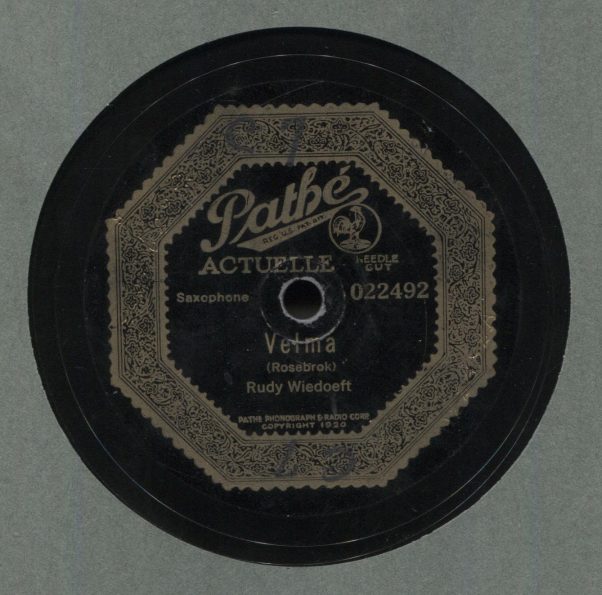
“Velma”
Rudy Wiedoeft
(Pathe 022492) October, 1920
“Puppe und Kobold” (“The Doll and the Goblin”)
Bravour Tanz-Orchester
(Odeon O 11878 mx Be 10379) June, 1933
By the end of the 1910s decade, ragtime started dying out in favor of jazz. But there were composers and artists who ran contrary to that trend.
One was composer and saxophone virtuoso Rudy Wiedoeft. Starting in 1917 with “Valse Erica,” he made solo recordings, many of which were of his own compositions that, even into the 1920s, were more ragtime than they were jazz.
His recording of “Velma” featured here, which he made for the Pathe label in October 1920, was among the first 78 rpm records I acquired as a child (though, as was the case with many records from the pre-microphone era, it was, in fact, recorded at 80 rpm). Wiedoeft made records for most of the American record labels in existence during that period and, besides Pathe, he recorded “Velma” for both Edison and Brunswick.
Though he was largely forgotten by the time of his death in 1940, from the late 1910s into the 1920s he enjoyed enormous celebrity through his appearances in vaudeville, on records and on radio. He was largely responsible for introducing the public to and popularizing the previously somewhat obscure saxophone which had a major impact on the popular music of the Jazz Age and beyond.
One aspiring teenage musician, whose first name was Hubert, was so impressed upon hearing one of Wiedoeft’s recordings that he switched instruments to the saxophone and sent off multiple fan letters before finally receiving a reply. He was so infatuated that he changed his professional name to “Rudy.” By the end of the 1920s, that teenager had become a big celebrity in his own right: bandleader, crooner and radio star Rudy Vallee.
Wiedoeft’s brother, Herb Wiedoeft, was also a musician and had an excellent dance band on the West Coast until he died in a traffic accident in 1928. A number of recordings by the Herb Wideoeft Orchestra are in Radio Dismuke’s playlist. But, somehow, this recording of “Velma” will only be the station’s third Rudy Wiedoeft recording – an oversight I will be correcting as I do have additional Wiedoeft records and have a standing order to myself to set them aside as I come across them.
The second recording featured here is an example of novelty ragtime, a new genre that Zes Confrey’s “Kitten on the Keys” helped popularize in the early 1920s. Unlike earlier ragtime compositions, which were primarily sold through sheet music intended for amateur musicians to play on parlor pianos, novelty rag compositions often had complex arrangements intended for professional musicians and were sold to the general public in the form of performances on piano rolls and phonograph records.
While the genre is sometimes referred to as “novelty piano,” full orchestra arrangements were occasionally performed by American dance bands throughout the 1920s. But novelty ragtime’s greatest popularity and where, in my opinion, the very best performances by dance bands were recorded, was in, of all places, Germany during the early and mid-1930s.
The two German bands that most prominently recorded it were Hans Bund’s Bravour Dance Orchestra (issued in England under the name Jack Bund) and Otto Dobrindt’s Piano Symphonists, although there were recordings by other bands as well. A number of novelty ragtime songs were written during that period by German composers, as was the selection featured here “Puppe und Kobold” (“The Doll and the Goblin”) by Jose Armandola, a pen name for German composer Wilhelm August Lautenschläger.
You can also hear two novelty ragtime recordings by Otto Dobrindt’s Piano Symphonists in this posting from August 2018.
